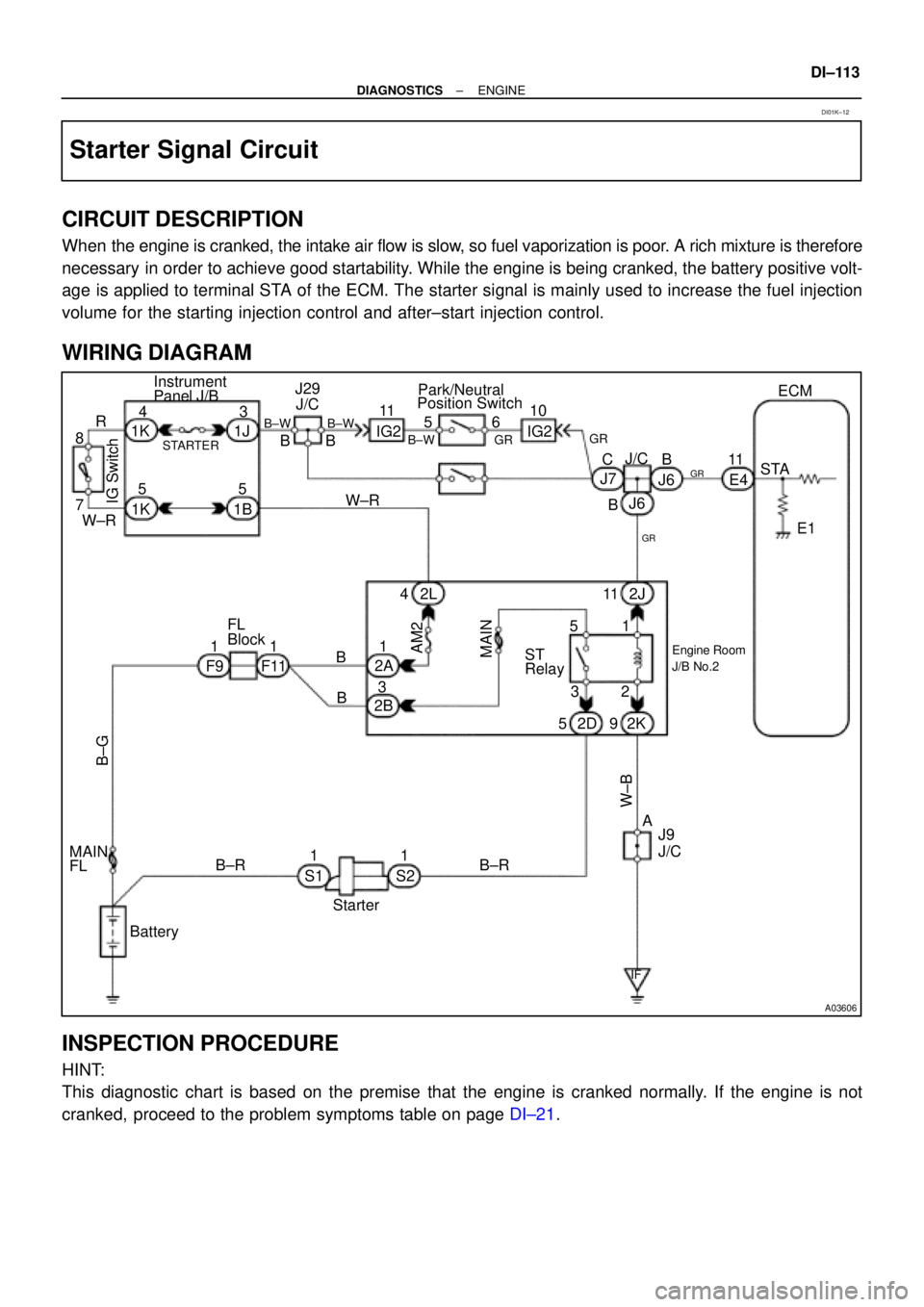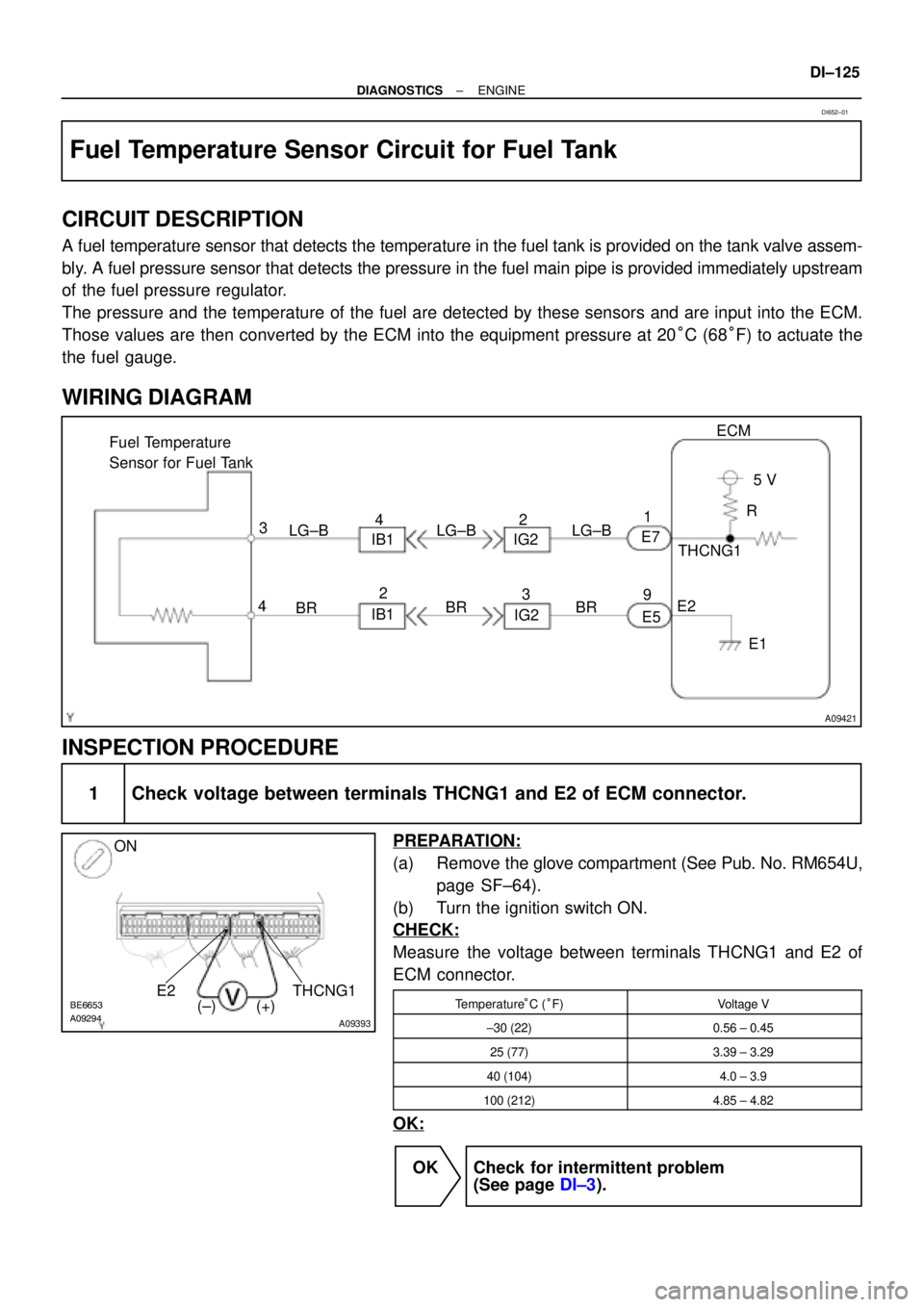Page 2263 of 4592

DI±112
± DIAGNOSTICSENGINE
DTC P1780 Park/Neutral Position Switch Malfunction
CIRCUIT DESCRIPTION
The park/neutral position switch goes on when the shift lever is in the N or P shift position. When it goes on
terminal NSW of the ECM is grounded to body ground via the starter relay thus the terminal NSW voltage
becomes 0V. When the shift lever is in the D, 2, L or R position, the park/neutral position switch goes off,
so the voltage of ECM. Terminal NSW becomes battery positive voltage, the voltage of the ECM internal
power source.
If the shift lever is moved from the N position to the D position, this signal is used for air±fuel ratio correction
and for idle speed control (estimated control), etc.
DTC No.DTC Detecting ConditionTrouble Area
2 or more switches are ON simultaneously for P, R, N, D, 2
and L positions (2 trip detection logic)
P1780
When driving under conditions (a) and (b) for 30 sec. or more
park/neutral position switch is ON (N position):
(2 trip detection logic)
(a) Vehicle speed: 80 km/h (50 mph) or more
(b) Engine speed: 2,000 ± 5,000 rpm�Short in park/neutral position switch circuit
�Park/neutral position switch
�ECM
HINT:
After confirming DTC P1780, use the TOYOTA hand±held tester to confirm the PNP switch signal from the
CURRENT DATA.
WIRING DIAGRAM
Refer to DTC P1780 on page DI±165.
INSPECTION PROCEDURE
HINT:
Read freeze frame data using TOYOTA hand±held tester or OBD II scan tool. Because freeze frame records
the engine conditions when the malfunction is detected. When troubleshooting it is useful for determining
whether the vehicle was running or stopped, the engine was warmed up or not, the air±fuel ratio was lean
or rich, etc. at the time of the malfunction.
Refer to DTC P1780 on page DI±165.
DI01J±07
Page 2264 of 4592

DI±112
± DIAGNOSTICSENGINE
DTC P1780 Park/Neutral Position Switch Malfunction
CIRCUIT DESCRIPTION
The park/neutral position switch goes on when the shift lever is in the N or P shift position. When it goes on
terminal NSW of the ECM is grounded to body ground via the starter relay thus the terminal NSW voltage
becomes 0V. When the shift lever is in the D, 2, L or R position, the park/neutral position switch goes off,
so the voltage of ECM. Terminal NSW becomes battery positive voltage, the voltage of the ECM internal
power source.
If the shift lever is moved from the N position to the D position, this signal is used for air±fuel ratio correction
and for idle speed control (estimated control), etc.
DTC No.DTC Detecting ConditionTrouble Area
2 or more switches are ON simultaneously for P, R, N, D, 2
and L positions (2 trip detection logic)
P1780
When driving under conditions (a) and (b) for 30 sec. or more
park/neutral position switch is ON (N position):
(2 trip detection logic)
(a) Vehicle speed: 80 km/h (50 mph) or more
(b) Engine speed: 2,000 ± 5,000 rpm�Short in park/neutral position switch circuit
�Park/neutral position switch
�ECM
HINT:
After confirming DTC P1780, use the TOYOTA hand±held tester to confirm the PNP switch signal from the
CURRENT DATA.
WIRING DIAGRAM
Refer to DTC P1780 on page DI±165.
INSPECTION PROCEDURE
HINT:
Read freeze frame data using TOYOTA hand±held tester or OBD II scan tool. Because freeze frame records
the engine conditions when the malfunction is detected. When troubleshooting it is useful for determining
whether the vehicle was running or stopped, the engine was warmed up or not, the air±fuel ratio was lean
or rich, etc. at the time of the malfunction.
Refer to DTC P1780 on page DI±165.
DI01J±07
Page 2265 of 4592

A03606
ECM
STA 11
E1 E4 Instrument
Panel J/BPark/Neutral
Position Switch
B
J6 J7
B CJ/C IG210 11
IG26 5
GR B±W
B±WGR B±W
J/C J29
B B 3
1J 4
1K
5
1B 1K5
STARTER
R
8
7
W±R
IG SwitchW±R
Engine Room
J/B No.2B
B FL
Block
B±G
B±R
BatteryStarter 11
W±B
A
J9
J/C
IF
42L
1
2A
3
2B
AM2
MAINST
Relay11 2 J
92K 52D 1 1
F11 F91 5
2 3
S2B±R MAIN
FL
GR
S1
GR
J6
± DIAGNOSTICSENGINE
DI±113
Starter Signal Circuit
CIRCUIT DESCRIPTION
When the engine is cranked, the intake air flow is slow, so fuel vaporization is poor. A rich mixture is therefore
necessary in order to achieve good startability. While the engine is being cranked, the battery positive volt-
age is applied to terminal STA of the ECM. The starter signal is mainly used to increase the fuel injection
volume for the starting injection control and after±start injection control.
WIRING DIAGRAM
INSPECTION PROCEDURE
HINT:
This diagnostic chart is based on the premise that the engine is cranked normally. If the engine is not
cranked, proceed to the problem symptoms table on page DI±21.
DI01K±12
Page 2268 of 4592
A09403
ECM
+B 12
E4 B±Y J/C
B
J24 J23B
B±Y
Instrument
Panel J/B 22J 2K7
W±R EFI
Relay 1 3
52
2F4
W±B
2A 1
AM2
42L
B
FL
Block
MAIN
FL
B±GEngine
J/B No.2
5
1B
531K71W
IGN
1K
Room
W±R
IG
Switch
7 6
E6
BR
B±R
EC
E1
F11
F9EB
1
1
EFI
J20
J/C A
A
Battery
BR
16 B±R DI±116
± DIAGNOSTICSENGINE
ECM Power Source Circuit
CIRCUIT DESCRIPTION
When the ignition switch is turned ON, battery positive voltage is applied to the coil, closing the contacts of
the EFI main relay (Marking: EFI) and supplying power to terminal +B of the ECM.
WIRING DIAGRAM
DI01L±07
Page 2271 of 4592
A09404
9
W±L
IJ2
E6 10
IG3
E6 18
LOCK IN
E1 16
EC
BRJ20
IJ210
BR 1
2A/C Compressor
Lock SensorECM
BR W±L
W±L
B
B BRJ/C
AA
A
BR
IG3 J7
6J/C
BR
± DIAGNOSTICSENGINE
DI±119
A/C Compressor Lock Sencor Circuit
CIRCUIT DESCRIPTION
This sensor sends 1 pulse par engine revolution to the ECM. If the number ratio of the compressor speed
divided by the engine speed is smaller than a predetermined value, the ECM turns the compressor off. And,
the indicator flashes at about 1 second intervals.
WIRING DIAGRAM
INSPECTION PROCEDURE
1 Check A/C compressor.
PREPARATION:
(a) Check the compressor drive belt tension (See Pub. No. RM654U, page AC±16).
(b) Check if the compressor does not lock during operation with the engine started, and the blower switch
and A/C switch ON.
NG Adjust drive belt tension or repair compressor
(See Pub. No. RM654U, page AC±17).
OK
DI01N±05
Page 2273 of 4592
A09405
E5
IG2 L±W1
L±R
THR5 V ECM
E2
E59
BR
IG23
BR A/C Evaporator
Temp. Sensor
2 110
A09290BE6653
A09361
ON
E1 THR
(±) (+)
± DIAGNOSTICSENGINE
DI±121
A/C Evaporator Temp. Sensor Circuit
CIRCUIT DESCRIPTION
This sensor detects the temperature inside the cooling unit and sends the appropriate signals to the ECM.
WIRING DIAGRAM
INSPECTION PROCEDURE
1 Check voltage between terminals THR and E2 of ECM connector.
PREPARATION:
(a) Remove the glove compartment (See Pub. No. RM654U,
page SF±64).
(b) Turn the ignition switch ON.
CHECK:
Measure the voltage between terminals THR and E1 of the
ECM connector at each temperature.
OK:
Voltage:
2.2 ± 2.6 V at 0°C (32 F)
1.4 ± 1.8 V at 15°C (59°F)
HINT:
As the temperature increases, the voltage decreases.
OK Check and replace ECM (See page IN±29).
DI01O±05
Page 2275 of 4592
A00309
ECM Fuel Pressure Sensor
for Fuel Pipe
1PCNG1VC
E2 Y
G±RE5
E7
E5 3
25 V
E1 1
5
9
BR
BE6653A03008A09254
ON
E2VC
(±) (+)
± DIAGNOSTICSENGINE
DI±123
Fuel Pressure Sensor Circuit for Fuel Pipe
CIRCUIT DESCRIPTION
Refer to DTC P0190 on page DI±56.
WIRING DIAGRAM
INSPECTION PROCEDURE
1 Check voltage between terminals VC and E2 of ECM connector.
PREPARATION:
(a) Remove the glove compartment (See Pub. No. RM654U,
page SF±64).
(b) Turn the ignition switch ON.
CHECK:
Measure the voltage between terminals VC and E2 of the ECM
connector.
OK:
Voltage: 4.5 ± 5.5 V
NG Check and replace ECM (See page IN±29).
OK
DI650±01
Page 2277 of 4592

A09421
E7
E51
9ECM
5 V
THCNG1
E2
E1 R
BR 3
4
BR Fuel Temperature
Sensor for Fuel Tank
BR IB1
IG2 LG±B
IB1IG2 LG±B LG±B 42
3 2
A09294BE6653
A09393
ON
THCNG1 E2
(±) (+)
± DIAGNOSTICSENGINE
DI±125
Fuel Temperature Sensor Circuit for Fuel Tank
CIRCUIT DESCRIPTION
A fuel temperature sensor that detects the temperature in the fuel tank is provided on the tank valve assem-
bly. A fuel pressure sensor that detects the pressure in the fuel main pipe is provided immediately upstream
of the fuel pressure regulator.
The pressure and the temperature of the fuel are detected by these sensors and are input into the ECM.
Those values are then converted by the ECM into the equipment pressure at 20°C (68°F) to actuate the
the fuel gauge.
WIRING DIAGRAM
INSPECTION PROCEDURE
1 Check voltage between terminals THCNG1 and E2 of ECM connector.
PREPARATION:
(a) Remove the glove compartment (See Pub. No. RM654U,
page SF±64).
(b) Turn the ignition switch ON.
CHECK:
Measure the voltage between terminals THCNG1 and E2 of
ECM connector.
Temperature°C (°F)Voltage V
±30 (22)0.56 ± 0.45
25 (77)3.39 ± 3.29
40 (104)4.0 ± 3.9
100 (212)4.85 ± 4.82
OK:
OK Check for intermittent problem
(See page DI±3).
DI652±01